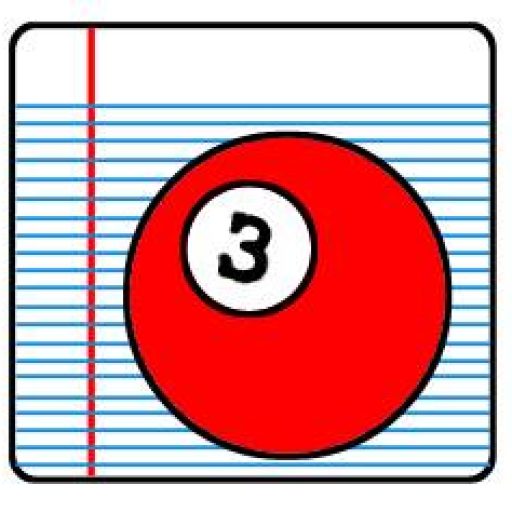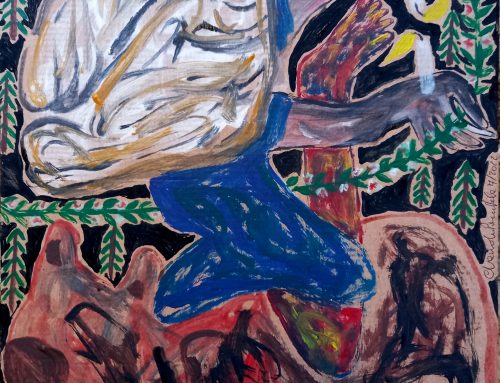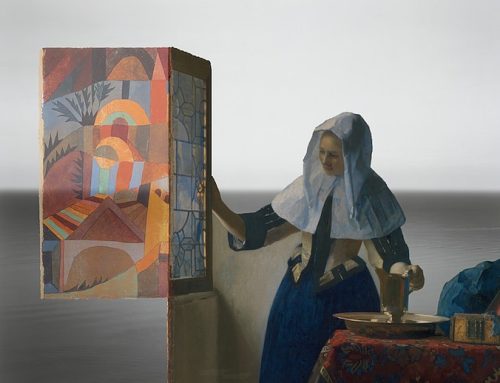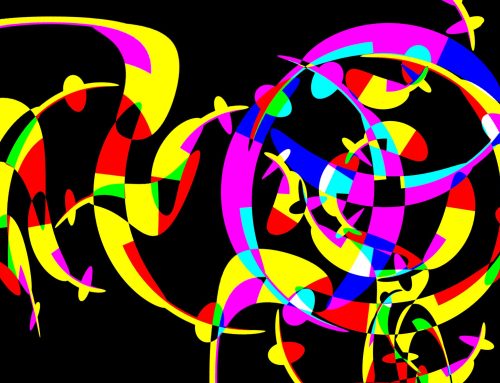At the Gates of Hell
by I. E. Sbace Weruld
Th’ Event Horizon Telescope Collaboration got
th’ first-ever photo of a black hole, Sauron’s selfie caught.
By using Very-Long-Baseline Interferometry,
eight telescopes were used in April 2017,
at Sagittarius A’s and M87’s holes,
like giant donuts, coffee-mug stains, torus cheerios.
The breakthrough, ring-of-fire, low-rez pics, if not sublime,
at least were there in colour “at the end of Space and Time”.
“It feels like one is looking at the gates of Hell,” he said,
astronomer professor Falke, speaking to the press.
On the Israeli Landing on the Moon
by I. E. Sbace Weruld
This week a private-funded spacecraft sent from Israel
dropped in to lunar orbit, round about its cratered trail.
It “was a mi-le-stone,” said one co-founder of SpaceIL
dubbed Beresheet, “in the Beginning,” on its techno sail.
The loops around the Moon then dwindled, slowing, moving down,
until the craft was set to land upon the lunar ground.
Each trace it took, anticipation balanced in the scale
of vast eternity within this grand and cosmic vale.
The trip was dangerous; it was so easy to derail;
but now it’s time to land and sit. The Moon is huge and pale.
I. E. Sbase Weruld is a poet of outer space.
________________________________________________________________
Haiku
by Ibe Ware Desu, LC
I drink from the stars.
The arc of the Big Dipper
curves above tree tops.
Ibe Ware Desu, LC, is a haiku-writer.
________________________________________________________________
Haiku
by Reiwa Celebuds
In a bamboo grove,
a sedentary panda
eats shoots all day long.
Reiwa Celebuds is a poet of spring.
________________________________________________________________
Shiing-shen Chern (1911-2004)
by Euclidrew Base
Shiing-shen Chern researched curves, surfaces and manifolds
in differential-geometric, fibre-spatial molds.
He introduced Chern classes, those asscoiated with
the complex vector bundles, topologic-vector pith.
His schooling was haphazard, but in 1932,
at Tsing-Hua University new planes came to his view.
From Hamburg, Wilhelm Blaschke came and gave some lectures on
the realms of web geometry, when it was in its dawn.
In 1934, he went to Hamburg, Germany;
and then to study with Cartan for one year in Paris.
He taught in Kunming during war, the Sino-Japanese,
and visited the IAS in 1943.
In 1946, he then returned to China till,
in ’49 the situation was untenable.
He spent the 1950s in Chicago teaching there;
and then from 1960, UC Berkeley was his lair.
In 1981, he helped set up MSRI;
in 1984, as well at Instutute Nankai.
In 1999, he came back to his Chinese home,
and died 2004, no longer needing more to roam.
Euclidrew Base is a poet of mathematics and mathematicians, IAS, Institute of Advanced Studies in Princeton, and MSRI, Mathematical Sciences Research Institute in Berkeley.
________________________________________________________________
A Chinese Cockroach
by Lu “Reed ABCs” Wei
Liao Yiwu was born in Sichuan
in 1958, the same year as
The Great Leap Forward, poet, musician,
and critic of the Chinese communists.
He writes about the marginalized folk,
the people government does not include,
except, of course, to forcibly enyoke
in prison, poverty, or prostitude.
“One has to have an iron stomach in
this pigsty, chew on rotten memories
through teeth and blood and broken bones. To win,
one lives with shame, pain and disgrace, disease,
snatches rides by chasing running trains—coach—
and rummages around like a cockroach.”
Lu “Reed ABCs” is a poet of China. This week Liao Yiwu, in Berlin, Germany, since 2011, said that China is a “threat to the World” and “my dream is China split up into 10 or more countries.” And now it seems that the US company Apple is censoring songs about the Tiananmen Square Massacre, in China—including certainly Liao Yiwu’s poem “Massacre” composed on the morning of June 4, 1989. For his poem Liao Yiwu was sentenced to four years in prison.
________________________________________________________________
In Dunedin
by Eric Awl De Beus
In 1887, Steell created it—
the statue of the Scottish poet Robert Burns
that’s in Otago’s Octagon in Dunedin,
near by the Anglican Cathedral of Saint Paul’s.
Made from red polished granite, draped in gray-blue coat,
the yellow-green lines down his face, that one discerns,
look like paint thrown from forehead high down past his throat.
Occasionally, one can see a seagull pause
upon his hair, to lend a brief, light-hearted note,
as Burns himself once did, to history’s hard laws;
but now, in heaviness, cut from life’s rocky mint,
he sits, beyond its nasty, brutish, short, harsh flaws.
Eric Awl De Beus is a poet of New Zealand. Dunedin is a city of 120,000 on the South Island. Robert Burns (1759-1796) was a Romantic Scottish poet. John Steell (1804-1891) was a Victorian Scottish sculptor.
________________________________________________________________
The Hamburg Television Tower at Sunset
by Uwe Carl Diebes
And even Hamburg Television Tower at sunset
appears as lonely as a slowly burning cigarette,
that closes down because of its asbestos residue,
the restaurant and then the bungee jumping base, due to
the decontamination, fire regulations. The old
must give way to the new, as Heinrich Hertz himself foretold,
who used his instruments to prove electromagnetic
waves real: they could be “heard” in wireless telegraphy,
and “seen” upon the television screen. Heinrich Hertz’ Term
was short; it only lasted for some thirty-six years firm.
Uwe Carl Diebes is a poet of Germany. German physicist Henrich Hertz lived from 1857 to 1894.
________________________________________________________________
The Gherkin
by Arcideb Usewel
The Gherkin climbs 180 meters in the sky,
a pickle called officially 30 St. Mary Axe.
Located at the heart of London’s finance distrct, it
is covered with clear di’mond panes that gleam when sunshine lit.
Its concept-circular plan, radial geometries,
for each floor to the lens on top do shift some five degrees.
Employed in its design is it sustainability;
the massive structure uses less in terms of energy.
Its office spaces are connected to cafes and shops
in an arcade from its piazza at its bottom stop.
Arcideb Usewel is a poet of architecture.
________________________________________________________________
Flemmings Beaubrun
by Cadwel E. Bruise
Although I find I disagree with him sometimes, still I
admire him for his prosaic renderings of life.
Within my mind, the words he writes do often resonate,
whatever topic he discuss with which I can relate.
His thoughts on driving, music, techno gadgets, and the like
flow through my mind’s gray matter with a panoply of light.
His thoughts on people, his profession, and his common sense
fill up my brain with thought and phrase; at times they are quite dense.
Perhaps ironic’lly, of all the writers that I’ve read,
I am most often taken by surprise by what he’s said.
Cadwel E. Bruise is a poet of New England.
________________________________________________________________
Fahrvergnügen
by Bruc “Diesel” Awe
130 Texas Highway in the spring is wonderful;
it’s freeing, fleeing lanes are open, fast and beautiful.
Escaping Austin’s sluggish traffic is one reason for
excursions down the open Pickle Parkway corridor.
Though changing tolls can keep one guessing what the cost will be
whatever one may pay is worth the taste of liberty.
The open sky, the wide gray road, effective miracles,
fly past the Airport and Circuit of the Americas.
Speed limits are as high as 85 miles-per-hour,
the fastest in the USA, and touched with lovely flow’r.
Pink ladies mingle with the yellow greenthread floral froths;
red indian paintbrushes mix with lush bluebonnet swaths.
130 Texas Highway is so good to see and drive,
a futuristic field that makes one glad one is alive.
Bruc “Diesel” Awe is a poet of transportation. Fahrvergnügen is German for driving-pleasure.
________________________________________________________________
He Was So Happy
by Scwidlee Ubare
“Clap along if you know what happiness is to you”
—Pharrell Williams
“How is the weather?”
—Alan Gordon and Gary Bonner
He was so happy there beneath those dark and splayed out palms
upon each side of his parked trunk, the sky’s display of alms,
the streaming streaks of gold and blue, above the silver sea,
beyond the railing at its edge, in beauty’s ecstasy.
He was so happy there below the surfboard standing tall
against the station wagon tow, beneath the solar ball,
beneath the faint and sandy beach, above the tee-shirt’s edge,
as he lay living, angling, hanging at the dangling ledge.
He was so happy there, although it would not be for long,
but having striven hard against the waves, he still felt strong.
Scwidlee Ubare is a poet of the beach. One of his favourite cartoon characters is Sponge Bob Square Pants. One of his favourite songs of the 1960s was the unrequited love song “Happy Together” sung by the Turtles, composed by Boston area musicians, Gordon & Bonner, and in the 2010s the carefree “Happy” by Pharrell Williams.
________________________________________________________________
That Door, That Manse
by Cee Saw Builder
He gazed upon that lovely door into another realm.
It was so beautiful, its beauty built to overwhelm.
O, was it safe to enter in, to center on its sill,
just being there, an opening to something grand…but still?
He pondered on its edges, which seemed plastic, but secure.
He paused upon that welcome mat, a warm inviting lure.
He wondered if some magic curse was holding it in place.
O, did he dare disturb that peaceful, pleasant, hopeful place?
He steeled his nerves, and firmed his will; he thought he’d take the chance,
but could he then come back again, and leave behind that manse?
Cee Saw Builder is a poet of carpentry.
________________________________________________________________
Nature’s Carpenters
by E. “Birdcaws” Eule
This morning I observed a morning dove beneath the bench,
from my bay window in the study, there below my chin.
At first I thought that he was searching for some grubs to eat;
but then I noticed it was slender twigs he longed to keep.
I watched him choose selectively the narrow wooden strands,
and then take off, but just near by—my porch’s gutter—Zounds!
I had to grab the ladder, climb up to th’ offending perch,
dismantle the accruing nest above my front door porch,
and keep a vigilant watch on such dove shenanigans
lest nature’s carpenters build on my roof-side annex-dens.
E. “Birdcaws” Eule is a poet of birds.
________________________________________________________________
I Saw Her
by I Warble Seduce
;for Maia
I saw her there, up in the sky; she was so beautiful.
She crossed love’s tightrope in the clouds, her balance wonderful.
She danced upon the garden roof-tops of the afternoon.
I saw her on a fountain gazing at a smiling moon.
I saw her in between the buildings reaching for a tree.
She floated lovely, freely, rolling through eternity.
She swirl’d around as if she were a flower in the wind.
I saw her petals whirl all about her, and I spinned.
I saw her rise, with purse in hand up past the statue’s form.
She touched the sky with butterflies. I felt so good and warm.
She swished her hair about her head, like strings let loose from time.
I saw her on the steps of spring. I saw her rise and climb.
I saw her angles and her curves, her body’s shape in turn.
She lay about the planters filled with ease and unconcern.
She leapt up from the morning, like soft doves within a stir.
I saw her dive into the World and swim, and I love her.
I Warble Seduce is a poet of amour.












Leave A Comment